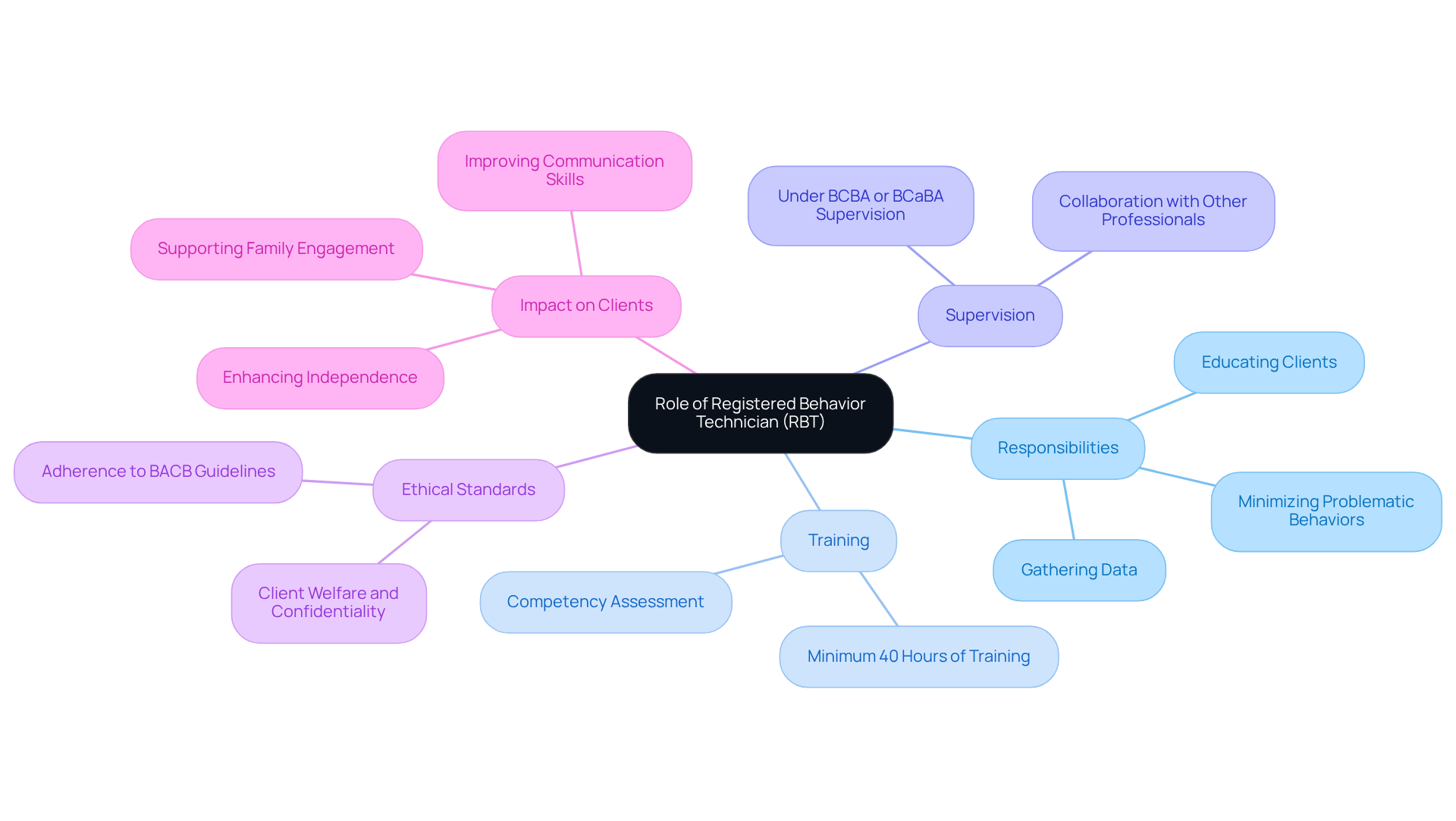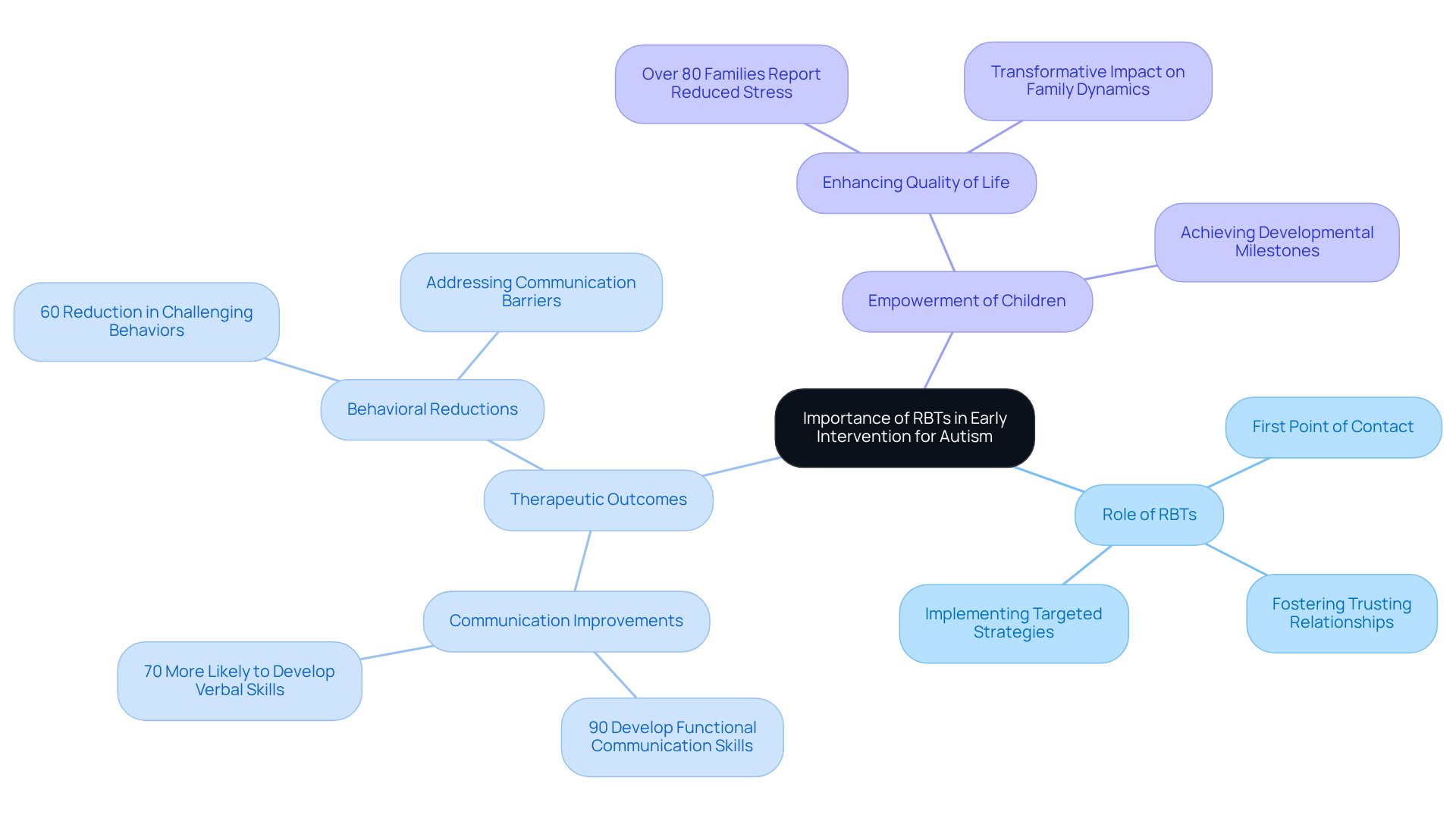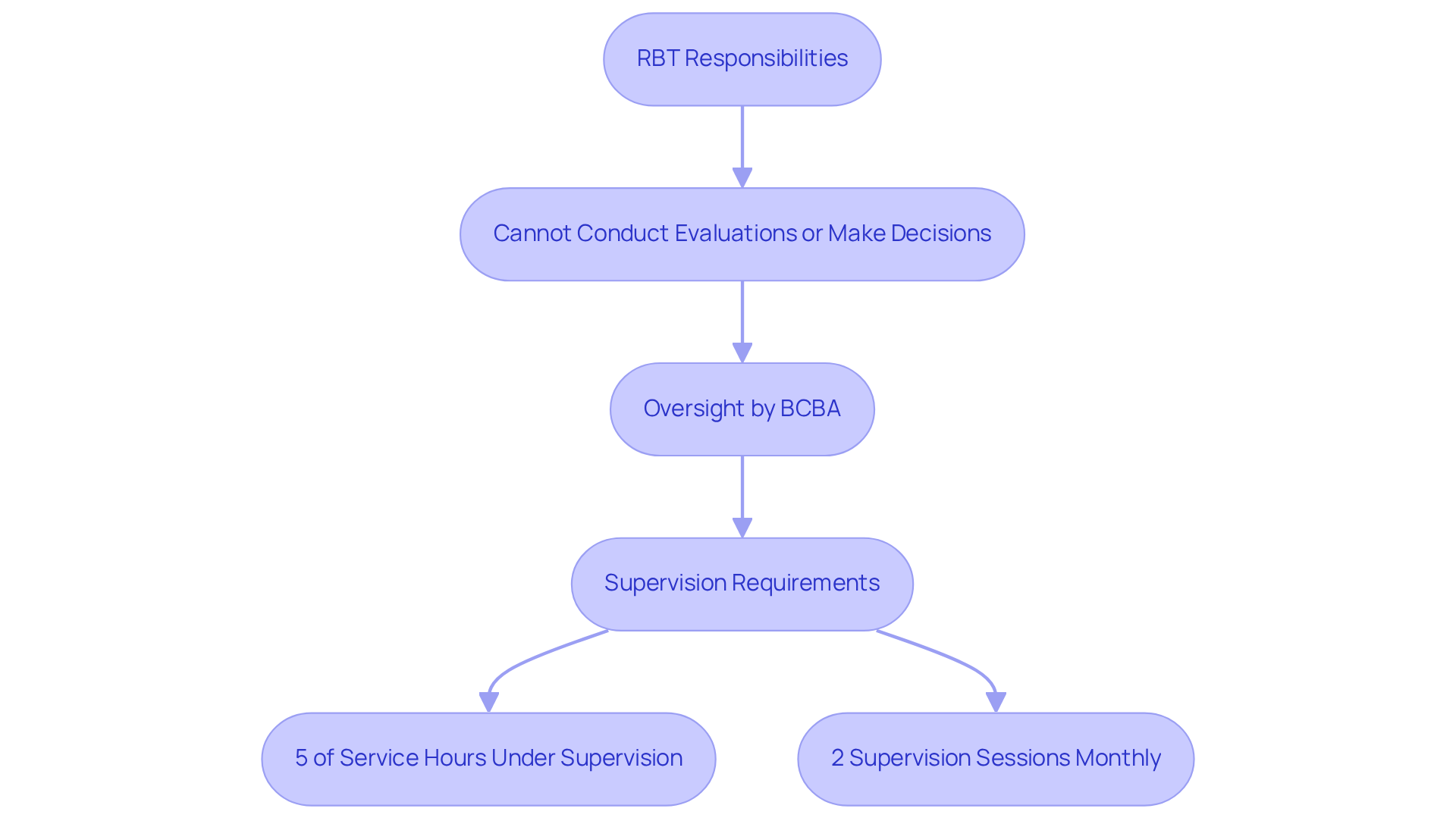September 12, 2025

Registered Behavior Technicians (RBTs) are pivotal in the realm of Applied Behavior Analysis (ABA) therapy, providing direct support to individuals with autism and other developmental disorders. They implement treatment plans and meticulously collect data on client progress. This role is not just important; it is essential. RBTs enhance clients' skills and manage challenging behaviors, significantly impacting their development.
Moreover, the effectiveness of RBTs is amplified through the guidance and supervision of Board Certified Behavior Analysts (BCBAs). This oversight ensures that interventions are both effective and ethical, reinforcing the critical nature of their work. Are you facing challenges in hiring qualified professionals for your ABA practice? Consider how leveraging the expertise of Hire ABA can streamline your recruitment process and connect you with the right talent.
In summary, the contribution of RBTs to ABA therapy cannot be overstated. Their dedication and skill are fundamental to the success of treatment plans, ultimately leading to improved outcomes for clients. Engage with Hire ABA today to explore how you can enhance your team with qualified RBTs and BCBAs, ensuring the highest standards of care in your practice.
Recognizing the vital role of Registered Behavior Technicians (RBTs) in Applied Behavior Analysis (ABA) therapy underscores a crucial element in supporting individuals with autism and developmental disorders. As the demand for effective therapeutic interventions escalates, RBTs stand out as essential contributors, implementing treatment plans and cultivating critical skills that foster greater independence and enhance quality of life.
Yet, what challenges do RBTs encounter in balancing their responsibilities with the limitations imposed by their profession? How can they navigate these complexities to maximize their impact?
A Registered Behavior Technician (RBT) is a paraprofessional who plays a crucial role in offering direct assistance to individuals with autism and other developmental disorders, highlighting what RBTs do through the application of Applied Behavior Analysis (ABA) therapy. With the increasing demand for Board Certified Behavior Analysts (BCBAs), it is essential to understand what RBTs do, as their role has never been more vital. Registered Behavior Technicians must complete at least 40 hours of training in behavior analysis and work under the supervision of Board Certified Behavior Analysts (BCBAs) or Board Certified Assistant Behavior Analysts (BCaBAs). They are tasked with executing treatment plans that focus on what RBTs do to enhance specific behavioral skills, which is essential for effective therapy.
Their responsibilities encompass:
To understand what RBTs do, it's important to recognize that Registered Behavior Technicians are frequently the main caregivers who engage with individuals every day, making their role essential in providing effective therapy. They help clients understand what RBTs do in order to and manage challenging behaviors, significantly impacting their quality of life.
Moreover, behavior technicians provide families with regular updates on their loved one's progress, enhancing family engagement in the therapeutic process. Have you considered how the right RBT can transform the outcomes for your clients? Case studies illustrate what RBTs do to enhance successful results in applied behavior analysis, including promoting independence and improving communication abilities in children with Autism Spectrum Disorder (ASD).
Their ongoing collaboration with BCBAs ensures that interventions are implemented accurately and adjusted based on data-driven insights, which helps clarify what RBTs do to further enhance the therapeutic process. Furthermore, registered behavior technicians must follow ethical standards established by the Analyst Certification Board (BACB), guaranteeing high levels of care and welfare for individuals. This commitment to ethical practice underscores the importance of hiring qualified RBTs to ensure the highest standards of care.

To understand the pivotal role in delivering Applied Behavior Analysis (ABA) therapy, one might ask what do RBTs do in executing a range of daily tasks that are crucial for the success of individuals undergoing treatment. Their primary responsibilities include:
On average, RBTs manage 4 to 6 clients each day, allowing them to focus on personalized care while ensuring strict adherence to treatment plans.
To become an RBT, candidates must complete a grounded in the BACB RBT Task List, equipping them with essential skills and knowledge. The average salary for Registered Behavior Technicians is approximately $33,000 per year, reflecting the financial dimensions of their role. Furthermore, RBT certification necessitates annual renewal with a fee of $35, underscoring the ongoing commitment required in this profession.
What do RBTs do in practice? They teach vital social skills, manage challenging behaviors, and implement reinforcement strategies to encourage positive behavior changes. For instance, they may employ visual aids and role-playing techniques to help individuals navigate social interactions more effectively. RBTs operate in three primary settings:
They tailor their approaches to fit the specific context of each environment. Regular communication with families and caregivers is also integral to their role, as RBTs provide updates on participant progress and share strategies for continued support outside of therapy sessions.
Board Certified Behavior Analysts (BCBAs) frequently express appreciation for the dedication and expertise that RBTs bring to therapy sessions, highlighting that their practical application is essential for translating theoretical treatment plans into effective real-world strategies. This collaborative dynamic not only enhances the efficacy of ABA therapy but also nurtures a supportive atmosphere for clients, ultimately facilitating their growth and development. Notably, around 85% of all ABA therapists are women, illustrating the demographic trends within the profession.
What do RBTs do? They play a crucial role in behavior reduction procedures and reinforcement strategies for addressing behavioral challenges, which are fundamental aspects of their responsibilities. The demand for Registered Behavior Technicians is significant, with an annual growth rate of approximately 20%, indicating a robust job outlook in the field.

In the early intervention process for children with autism, many wonder what do RBTs do, as they are pivotal and frequently serve as the first point of contact in therapy. Their consistent interactions foster trusting relationships, which are essential for effective therapeutic outcomes.
Research indicates that early intervention can yield significant improvements in communication, social skills, and overall behavior. For example, up to 90% of children receiving early intervention develop functional communication skills, underscoring the transformative impact of behavior technicians.
By implementing targeted strategies and providing prompt feedback, trained professionals facilitate the achievement of developmental milestones, greatly enhancing the quality of life for these children.
Case studies demonstrate that children in early intervention programs experience a 60% reduction in challenging behaviors within six months, as they address communication barriers and sensory sensitivities. This further highlights the in supporting children’s growth across various environments, including home and school.
Their role transcends mere strategy implementation; when considering what do RBTs do, it’s about empowering children to thrive socially and emotionally, laying the groundwork for future success.

Certified Technicians are essential in delivering ABA therapy, yet they operate within specific limitations. Registered Technicians cannot conduct evaluations, formulate treatment strategies, or make clinical decisions independently; these responsibilities are reserved for Board Certified Analysts. The oversight of a BCBA is crucial, as they offer the necessary guidance to ensure interventions are both suitable and effective.
To understand what RBTs do, it's important to note that they must comply with the (BACB), which requires receiving a minimum of 5% of their total service hours under supervision each month. This includes at least two supervision sessions, one of which must involve direct observation.
Such structured oversight not only enhances the RBT's competencies, answering the question of what RBTs do, but also ensures adherence to ethical practices, ultimately safeguarding the quality of care provided to individuals. Neglecting these supervision requirements can result in certification lapses and potential harm to clients, highlighting the vital importance of appropriate oversight.
Case studies indicate that effective BCBA supervision markedly improves RBT performance and client outcomes, underscoring the significance of this supervisory relationship in the realm of ABA therapy.

Registered Behavior Technicians (RBTs) play a crucial role in the implementation of Applied Behavior Analysis (ABA) therapy, providing vital support to individuals with autism and other developmental disorders. Their contributions are indispensable; they not only execute treatment plans but also engage directly with clients to promote skill development and manage challenging behaviors. The effectiveness of RBTs in enhancing the quality of life for those they serve highlights the essential nature of their work within the therapeutic framework.
This exploration has illuminated the key responsibilities of RBTs, encompassing daily tasks such as:
Their collaboration with Board Certified Behavior Analysts ensures that interventions are customized to meet individual needs while upholding ethical standards. This partnership is critical for translating theoretical approaches into practical, impactful strategies that yield significant improvements in clients' behaviors and skills.
Acknowledging the importance of RBTs in early intervention for autism is paramount, as their consistent interaction with clients fosters trust and facilitates meaningful progress. The positive outcomes associated with their work, including enhanced communication and diminished challenging behaviors, underscore the transformative potential of effective ABA therapy. As the demand for RBTs continues to rise, it is vital to recognize their unique contributions and advocate for their essential role in supporting individuals on their path toward independence and success.
What is the role of a Registered Behavior Technician (RBT)?
A Registered Behavior Technician (RBT) is a paraprofessional who provides direct assistance to individuals with autism and other developmental disorders through the application of Applied Behavior Analysis (ABA) therapy.
What qualifications are required to become an RBT?
Registered Behavior Technicians must complete at least 40 hours of training in behavior analysis and work under the supervision of Board Certified Behavior Analysts (BCBAs) or Board Certified Assistant Behavior Analysts (BCaBAs).
What are the main responsibilities of an RBT?
The main responsibilities of an RBT include educating clients in new skills, minimizing problematic behaviors, and gathering data on individual progress to assess the effectiveness of interventions.
How do RBTs impact the quality of life for their clients?
RBTs help clients develop essential skills for independence and manage challenging behaviors, significantly enhancing their quality of life.
How do RBTs engage with families during the therapeutic process?
RBTs provide families with regular updates on their loved one's progress, which enhances family engagement in the therapeutic process.
What ethical standards do RBTs follow?
Registered Behavior Technicians must adhere to ethical standards established by the Analyst Certification Board (BACB), ensuring high levels of care and welfare for individuals.
Why is collaboration with BCBAs important for RBTs?
Ongoing collaboration with BCBAs ensures that interventions are implemented accurately and adjusted based on data-driven insights, which enhances the therapeutic process.
How can the right RBT transform outcomes for clients?
The right RBT can significantly enhance successful results in applied behavior analysis, including promoting independence and improving communication abilities in children with Autism Spectrum Disorder (ASD).
Our expert recruitment strategies and AI-driven sourcing ensure that you receive top-notch candidates quickly, without compromising on quality. Whether you’re looking for BCBAs, Clinical Directors, or RBTs, we’ve got you covered.